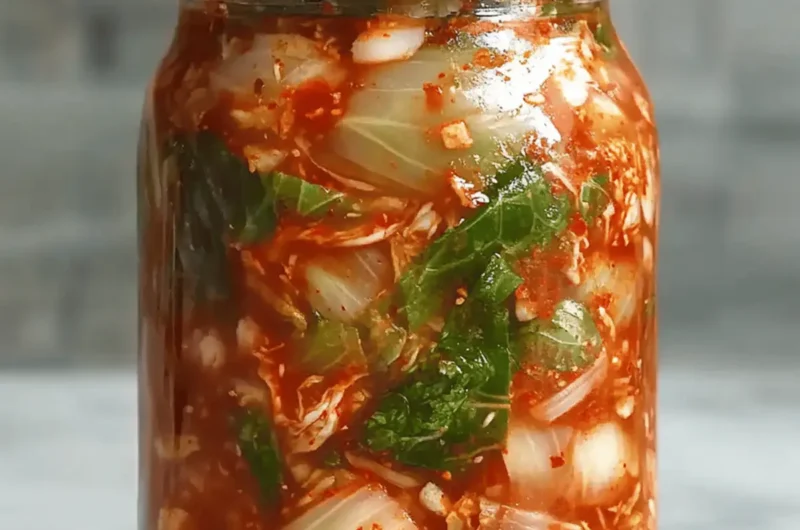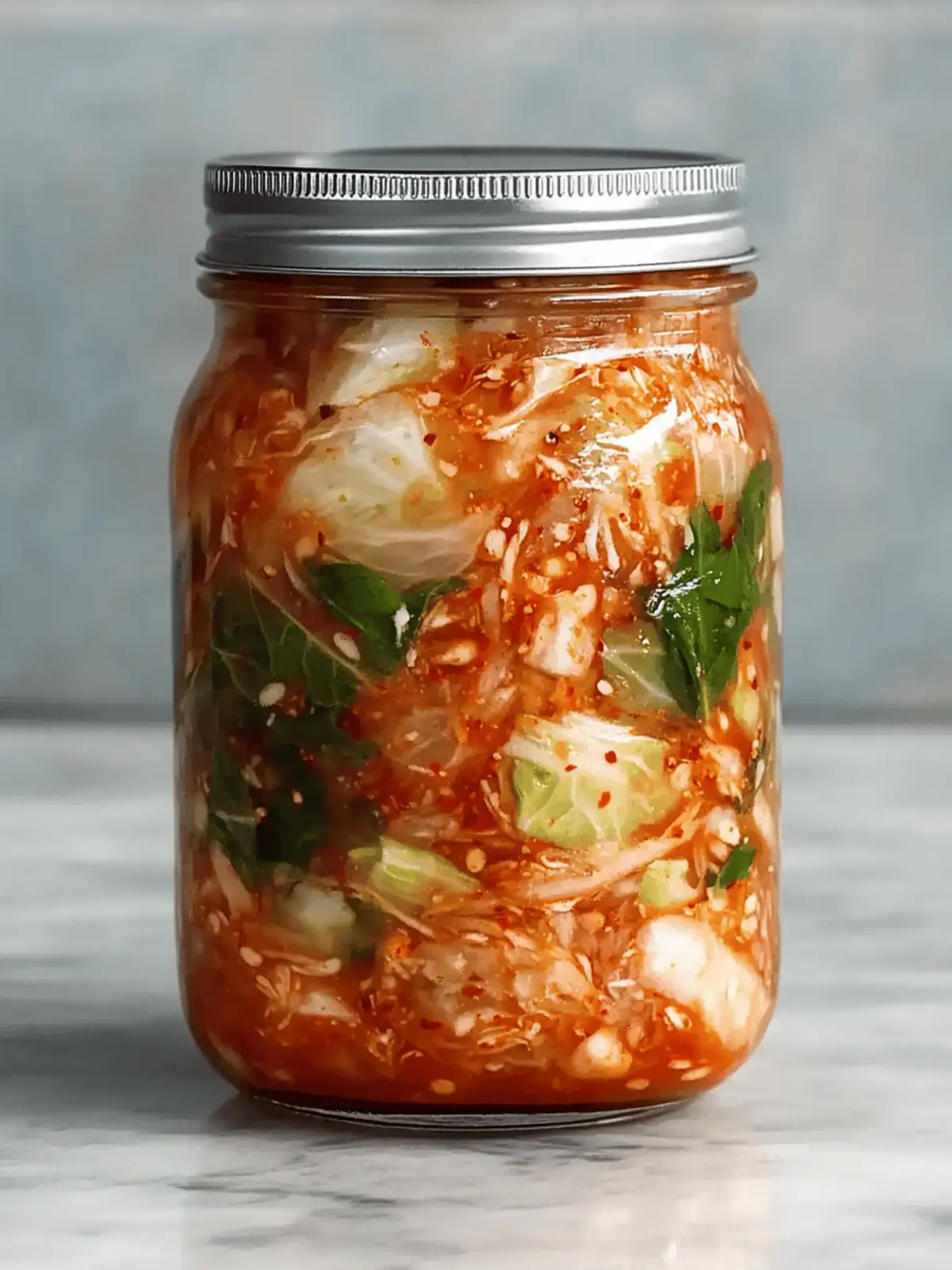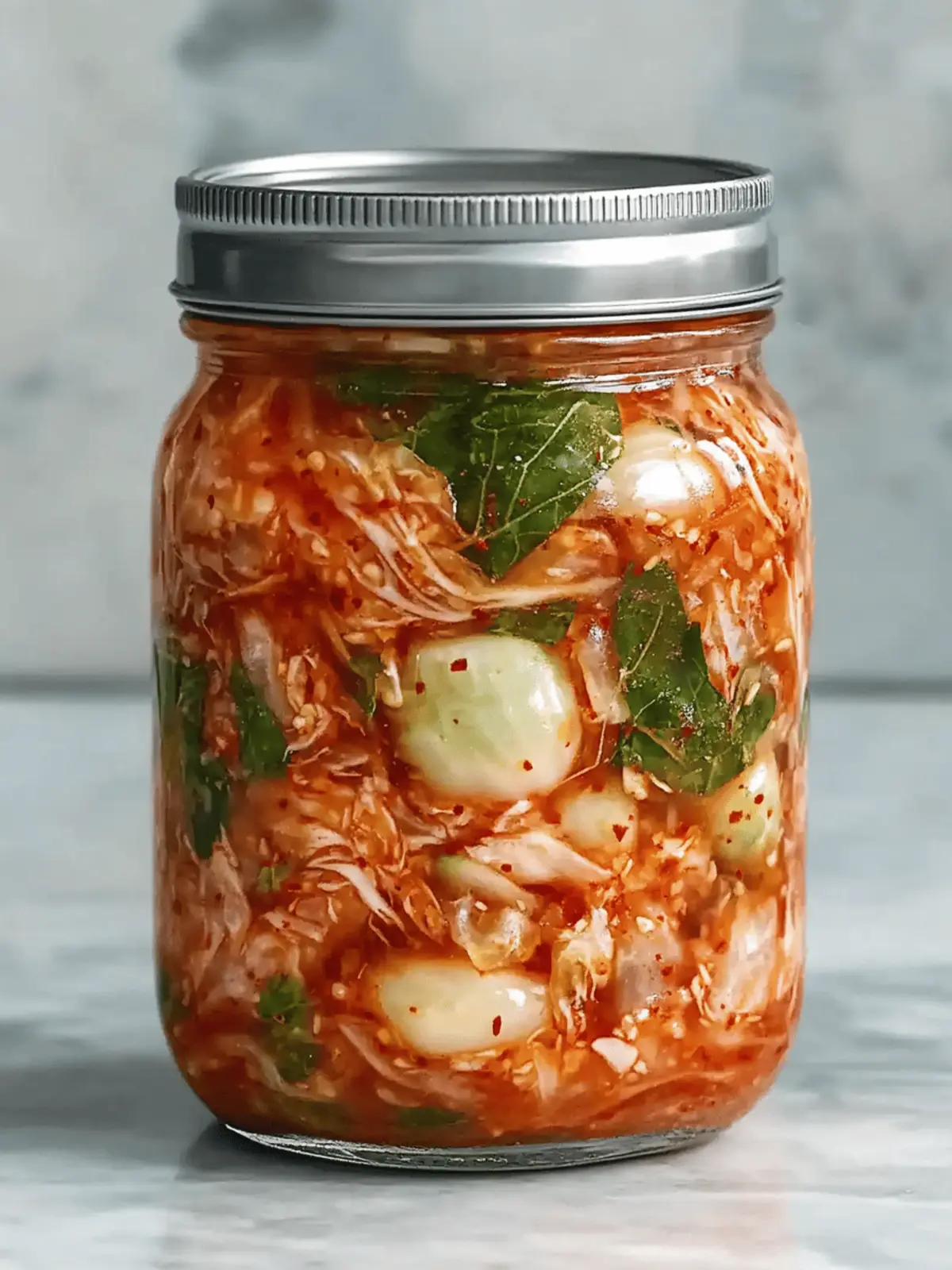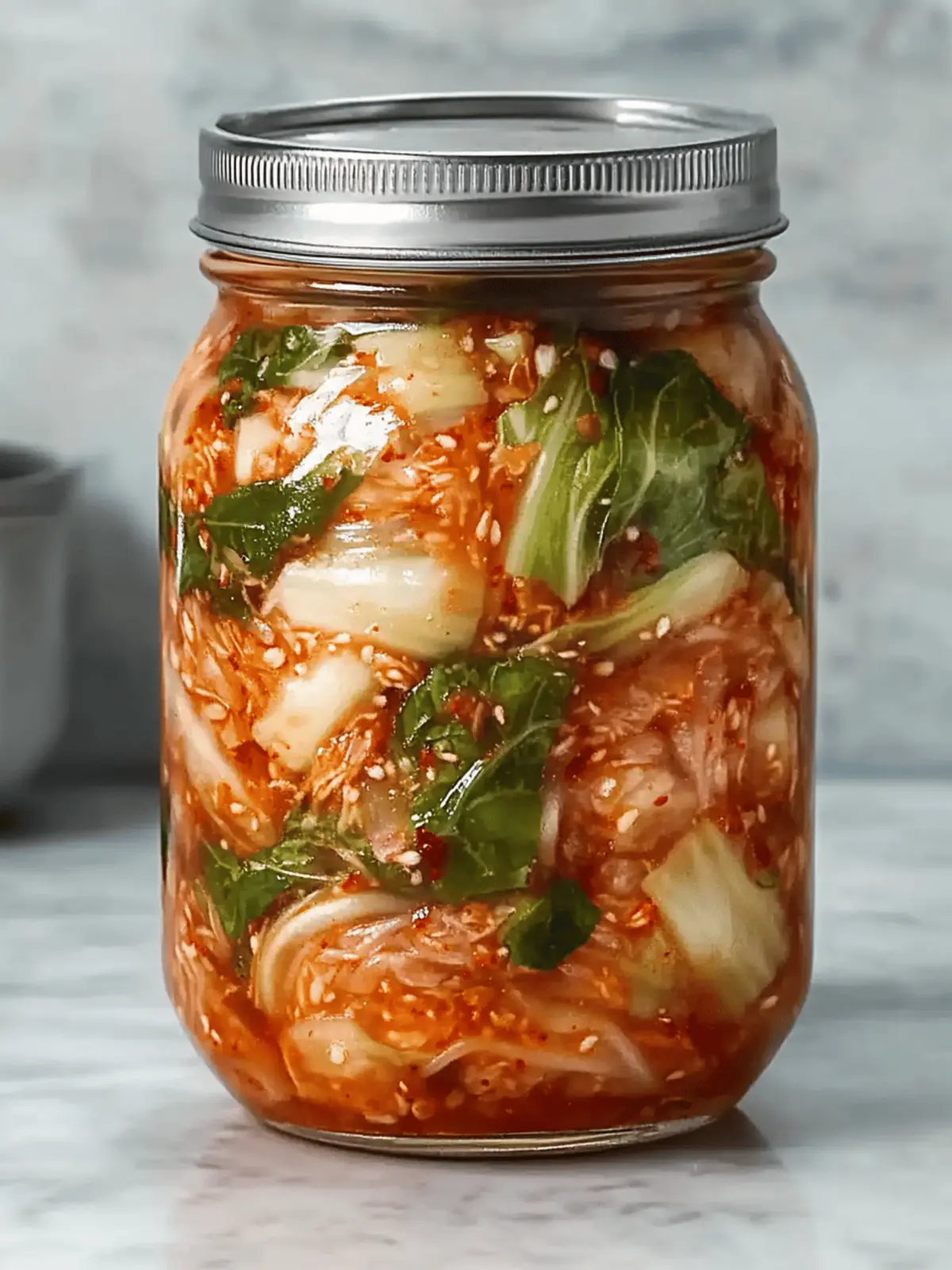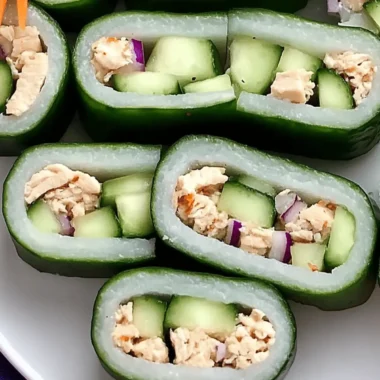There’s a certain joy that comes from crafting your own homemade fermented cabbage kimchi, and when you take that first bite, it’s like a vibrant explosion of flavor. Picture the cool crunch of napa cabbage coated in a spicy, tangy paste that’s been lovingly prepared and fermented to perfection. Not only does this kimchi elevate any meal—from a simple rice bowl to an extravagant Korean BBQ feast—but it’s also a powerhouse of probiotics that supports gut health.
I remember the thrill of first attempting this traditional recipe, my kitchen filled with the fragrance of garlic and ginger as each ingredient came together. The best part? It requires minimal prep, letting the magic of fermentation do all the heavy lifting. Whether you’re a seasoned chef or a home-cook looking to spice things up, this fermented cabbage kimchi is a must-try. Let’s dive into the delightful world of homemade kimchi and discover just how easy and rewarding it is!
Why is Fermented Cabbage Kimchi a Must-try?
Unique Flavor Adventure: Each bite is a burst of spicy, tangy goodness that transforms ordinary dishes into flavorful feasts.
Health Benefits: Packed with probiotics, this kimchi supports gut health and digestion while being low in calories.
Easy Homemade Fun: With just a few simple ingredients and minimal hands-on time, you can create something spectacular.
Versatile Use: Perfect as a side, in rice bowls, or even in salads, this kimchi brings life to any meal.
Long-lasting Edible Gold: Properly fermented, it lasts for months, allowing you to enjoy homemade goodness anytime.
Ingredients for Fermented Cabbage Kimchi
For the Kimchi Base
• Napa Cabbage – The star of this dish, providing a crisp texture; you can substitute with green cabbage if needed.
• Salt – An essential ingredient for brining that helps draw out moisture; kosher salt is ideal, as it has no additives.
For the Spicy Paste
• Korean Red Pepper Flakes (Gochugaru) – The secret to that signature heat and vibrant color; if you prefer less spice, crushed red pepper flakes work well.
• Fish Sauce – Adds a deep umami flavor to the mix; for a vegetarian version, replace this with soy sauce or miso paste.
• Garlic – Essential for flavor and aroma; adjust the amount based on your personal taste.
• Ginger – Infuses freshness into the kimchi; feel free to use ginger paste or omit if you’re not a fan.
For Balancing Flavor
• Sugar – Helps to balance the heat from the gochugaru; honey or agave syrup can be used as substitutions.
This fermented cabbage kimchi is not only delicious but also a wonderful addition to your healthy eating habits! Enjoy crafting this vibrant delight in your kitchen.
How to Make Fermented Cabbage Kimchi
-
Prepare Ingredients: Begin by chopping the napa cabbage into quarters. Sprinkle salt evenly over the cabbage and let it sit in a large bowl for 1-2 hours until it wilts, reducing its volume. After that, rinse it well to remove excess salt and drain thoroughly.
-
Make Kimchi Paste: In a small bowl, blend together the gochugaru, fish sauce, minced garlic, grated ginger, and sugar until you form a thick, red paste that’s aromatic and spicy. Adjust to your preferred spice level!
-
Combine: In a large mixing bowl, take the wilted cabbage and carefully mix it with the kimchi paste. Use your hands (wear gloves if desired!) and ensure every piece of cabbage is well coated in this spicy goodness.
-
Pack & Ferment: Transfer the cabbage and paste mixture into a clean, airtight jar. Press down firmly to eliminate any air pockets, filling the jar to about an inch from the top to allow fermentation expansion.
-
Ferment: Seal the jar and place it at room temperature for 1-5 days. Check the kimchi daily for tanginess until it reaches your preferred flavor. Once ready, store it in the refrigerator to slow fermentation.
Optional: Add grated carrots or daikon radish for extra crunch and sweetness!
Exact quantities are listed in the recipe card below.
Make Ahead Options
These fermented cabbage kimchi options are perfect for busy home cooks looking to simplify meal prep! You can chop and salt the napa cabbage up to 24 hours in advance, allowing it to wilt in the fridge, which reduces prep time on the day you intend to make the kimchi. Additionally, you can prepare the kimchi paste (gochugaru, fish sauce, garlic, ginger, and sugar) a day before and store it in the refrigerator. When you’re ready to finish up, simply combine the wilted cabbage with the paste, pack it into your jar, and let it ferment as directed. This way, you’ll enjoy fresh and flavorful kimchi without the last-minute rush!
Expert Tips for Fermented Cabbage Kimchi
-
Clean Tools: Always use clean utensils when preparing and packing kimchi to prevent contamination and prolong its shelf life.
-
Taste Test: Sample the kimchi daily to gauge the fermentation process. If it becomes overly sour, it can still be used in cooking.
-
Adjust Spice: Start with a moderate amount of gochugaru and gradually increase based on your heat preference, ensuring your fermented cabbage kimchi suits your taste.
-
Store Properly: Store the jar in a cool, dark place during fermentation. A cool temperature ensures a balanced fermentation and prevents spoilage.
-
Time Matters: Remember, fermentation time varies based on temperature and desired tanginess. Warmer environments speed up fermentation, so check daily!
How to Store and Freeze Fermented Cabbage Kimchi
Fridge: Store your kimchi in the refrigerator to maintain its crisp texture and flavors for up to 6 months. Ensure it’s in a clean, airtight container for optimal freshness.
Freezer: If you’d like to keep it longer, freeze the kimchi in an airtight container or freezer bag for up to a year. Note that texture may change once thawed.
Room Temperature: After initial fermentation, if you prefer a strong tangy flavor, kimchi can be stored at room temperature for up to 5 days; monitor daily for desired taste.
Reheating: You can enjoy kimchi straight from the fridge or add it to stir-fries or soups. It doesn’t require cooking, retaining its beneficial probiotics even when heated.
Variations & Substitutions for Fermented Cabbage Kimchi
Embrace your culinary creativity and make this recipe your own with some delightful twists!
- Dairy-Free: Replace fish sauce with soy sauce or tamari for a plant-based umami flavor, perfect for vegans.
- Extra Crunch: Add grated carrots and daikon radish to the cabbage for a sweet crunch that brightens every bite, enhancing texture and flavor.
- Flavor Fusion: Mix in a tablespoon of miso paste along with the kimchi paste for depth and an earthy taste that complements the spicy kick.
- Smoky Twist: Incorporate a dash of smoked paprika for a warm, smoky flavor that adds another dimension to your kimchi experience.
- Sweet & Spicy: Add thinly sliced apple or pear for a sweet contrast to the spiciness, creating a refreshing mix of flavors.
- Heat Level: Adjust the amount of gochugaru based on your spice tolerance; use less for a milder kimchi or experiment with additional chili flakes for extra heat!
- Herb Kicker: Toss in some chopped green onions or cilantro before packing the kimchi for a zesty touch that elevates the flavor profile.
- Fermentation Finish: Use a mix of vegetables such as cucumbers or radishes to make a colorful, varied batch, introducing seasonal flavors to your offering.
With these exciting variations, you’re all set to turn your homemade kimchi into a personal culinary masterpiece!
What to Serve with Fermented Cabbage Kimchi?
Transform your meal with delightful additions that enhance the spicy, tangy excellence of kimchi.
- Grilled Korean BBQ: The smoky flavors of BBQ meats perfectly contrast with the crispness of the kimchi, making every bite an adventure.
- Steamed White Rice: A bowl of fluffy rice acts as a soft canvas, soaking up the bold kimchi juices and cooling the spice.
- Savory Stir-Fried Noodles: Tossed with vegetables, the umami flavors of stir-fried noodles are elevated when paired with kimchi’s zing.
- Spicy Tofu Stew: The richness of this hot stew complements kimchi’s crunch and tang, creating a soothing yet exciting meal experience.
- Fresh Cucumber Salad: A light and refreshing salad can help balance out the spice, with crispy cucumbers offering a cool contrast.
- Kimchi Fried Rice: Embrace the full circle by using your kimchi in a vibrant fried rice dish, its flavors mingling for a hearty meal.
- Cold Beer or Soju: These beverages can enhance your dining experience, providing a refreshing counterbalance to the bright and spicy flavors of your kimchi.
- Chewy Rice Cakes (Tteokbokki): The chewy texture adds an enjoyable bite that pairs beautifully with the tangy heat of the kimchi.
Fermented Cabbage Kimchi Recipe FAQs
What kind of cabbage should I use for kimchi?
Absolutely, napa cabbage is the traditional choice for making kimchi due to its crisp texture and ability to soak up flavors. If you can’t find napa cabbage, feel free to substitute with green cabbage or savoy cabbage, which will still yield delicious results.
How should I store my fermented cabbage kimchi?
After the initial fermentation, store your kimchi in the refrigerator in a clean, airtight container to keep it fresh and crispy for up to 6 months. The cool environment will help maintain its flavor while also allowing the beneficial probiotics to thrive. Just make sure to press it down every time you open the jar to remove any trapped air!
Can I freeze kimchi, and if so, how?
Yes! For longer preservation, you can freeze your fermented cabbage kimchi. Just portion the kimchi into an airtight container or freezer bag, ensuring to remove as much air as possible before sealing. It will keep well for about a year. When you’re ready to use it, simply thaw it in the refrigerator overnight. Do keep in mind the texture might change slightly after freezing, but the flavor will still be delightful!
What should I do if my kimchi is too salty or too spicy?
If you find your kimchi too salty, try rinsing it lightly under cold water to reduce the saltiness before serving. To balance an overly spicy kimchi, you can mix in some extra chopped cabbage or add a diced, cooked potato to absorb some heat. Taste as you go to achieve your desired spice level!
Is kimchi safe for everyone to eat?
While kimchi is rich in probiotics and health benefits, consider potential allergies—especially to fish sauce if you’re using it. For a vegetarian option, substitute fish sauce with soy sauce or miso paste. Always consult with your healthcare provider if you have concerns about fermented foods, especially for pets or any dietary restrictions.
How do I know when my kimchi is ready?
The timing for fermentation can vary significantly depending on the temperature and your desired level of tanginess. Check your kimchi daily, which I often recommend, until it reaches that perfect, slightly sour flavor. It typically takes 1 to 5 days at room temperature. If it’s bubbling and has a slightly sour aroma, it’s a good sign that it’s ready for the fridge!

Fermented Cabbage Kimchi: Spice Up Your Gut Health Today!
Ingredients
Equipment
Method
- Prepare Ingredients: Chop the napa cabbage into quarters, sprinkle with salt, let sit for 1-2 hours, rinse and drain.
- Make Kimchi Paste: Blend gochugaru, fish sauce, garlic, ginger, and sugar into a thick paste.
- Combine: Mix wilted cabbage with kimchi paste until well coated.
- Pack & Ferment: Transfer mixture into a clean jar, pressing down to eliminate air pockets.
- Ferment: Seal jar and place at room temperature for 1-5 days, checking daily.

